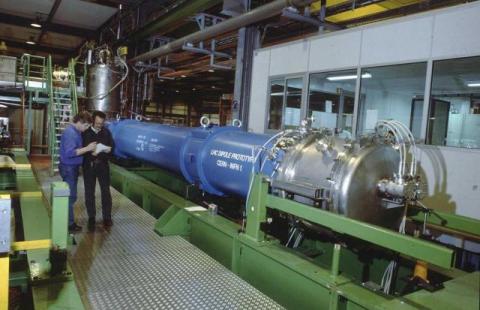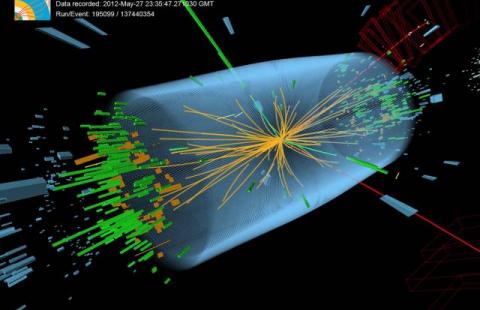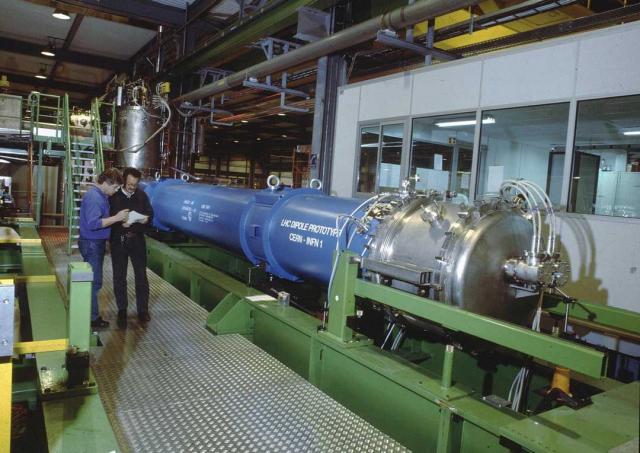
US president announces support for Superconducting Super Collider
With US President Ronald Reagan’s support,…
Know more
ATLAS and CMS collaborations publish letters of intent
The Toroidal LHC Apparatus collaboration propose…
Know more
ALICE collaboration publishes letter of intent
The collaboration for A Large Ion Collider…
Know moreSuperconducting Super Collider project cancelled
Due to concerns linked to rising costs, the US…
Know more
10-metre magnet prototype achieves 8.73 Tesla
The first prototype bending-magnet for the LHC…
Know more


TOTEM collaboration publishes letter of intent
The Total Cross Section, Elastic Scattering…
Know more
United States admitted as CERN observer state
At the December session of the CERN council,…
Know more
MoEDAL collaboration publishes letter of intent
The Monopole and Exotics Detector at the LHC…
Know more
Gallo-Roman ruins discovered at CMS dig site
As construction workers are preparing the work…
Know more

Final large detector piece lowered into ATLAS cavern
A component known as a small wheel is the last…
Know moreFinal large detector piece lowered into CMS cavern
The pixel detector barrel is the last large piece…
Know more

Final magnet goes underground after LHC repair
The 53rd and final replacement magnet for the…
Know more
The LHC starts again after a short technical stop
After a short technical stop, beams circulate…
Know more
LHC proton run for 2011 reaches successful conclusion
On 18 October 2011, the grand total of data…
Know more

ATLAS and CMS observe a particle consistent with the Higgs boson
On 4 July 2012, as a curtain raiser to the year…
Know more
François Englert and Peter W. Higgs awarded 2013 Nobel Prize in Physics
François Englert (left) and Peter Higgs at CERN…
Know moreCERN’s Large Hadron Collider gears up for run 2
Run 2 of the LHC follows a 2-year technical stop…
Know moreCMS and LHCb experiments reveal decay of the B0s particle into two muon particles
Published in Nature, the CMS and LHCb…
Know more
LHC experiments back in business at record energy of 13 TeV
From an update on the CERN website: The…
Know moreThe LHC MoEDAL experiment publishes its first paper on its search for magnetic monopoles
In a paper published by the journal JHEP,…
Know moreAs the number of particles produced in proton collisions (the blue lines) increase, the more of these so-called strange hadrons are seen (as shown by the red squares in the graph). (Image: CERN) (Image: CERN) ALICE experiment results show novel phenomena in proton collisions
In a paper published in Nature Physics, the…
Know moreThe LHCb experiment is charmed to announce observation of a new particle with two heavy quarks
At the EPS Conference on High Energy Physics in…
Know more
Embed this timeline
A Large Hadron Collider in the LEP Tunnel?

US president announces support for Superconducting Super Collider
ATLAS and CMS collaborations publish letters of intent

ALICE collaboration publishes letter of intent

Superconducting Super Collider project cancelled
10-metre magnet prototype achieves 8.73 Tesla

LHC construction approved
Japan admitted as CERN observer state

LHC Conceptual Design Report published

CMS and ATLAS experiments approved
ALICE experiment approved
TOTEM collaboration publishes letter of intent

United States admitted as CERN observer state

MoEDAL collaboration publishes letter of intent

Gallo-Roman ruins discovered at CMS dig site

LHCb experiment approved
Final excavation of the ATLAS cavern

Reinforcing the ATLAS cavern floor

ATLAS cavern inaugurated
LHCf submits letter of intent
CMS cavern inaugurated
Last LHC dipole magnet goes underground
Final large detector piece lowered into ATLAS cavern
Final large detector piece lowered into CMS cavern
The LHC starts up

Incident at the LHC
Inauguration of the LHC

Final magnet goes underground after LHC repair
Beams back in the LHC
The LHC is put into standby mode
The LHC starts again after a short technical stop

First LHC collisions at 7 TeV

Martin Aleksa, Lyndon Evans, Fabiola Gianotti and Peter Jenni toast running at 7 TeV in the ATLAS Control Room. (IMAGE: CERN)
LHC proton run for 2011 reaches successful conclusion
Tantalising hints of the Higgs
Record collision energy of 8TeV

ATLAS and CMS observe a particle consistent with the Higgs boson

ATLAS spokesperson, Fabiola Gianotti, presents the collaboration's results. (IMAGE: CERN)
End of LHC Run 1: First shutdown begins
François Englert and Peter W. Higgs awarded 2013 Nobel Prize in Physics

CERN’s Large Hadron Collider gears up for run 2
CMS and LHCb experiments reveal decay of the B0s particle into two muon particles
LHC experiments back in business at record energy of 13 TeV

The LHC MoEDAL experiment publishes its first paper on its search for magnetic monopoles

ALICE experiment results show novel phenomena in proton collisions
